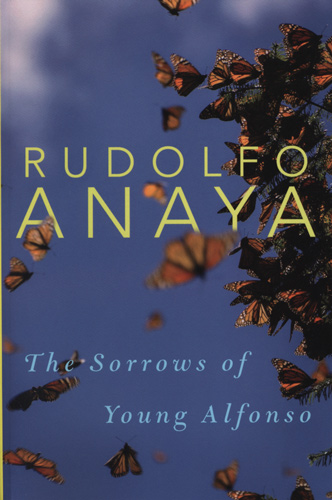The Sorrows of Young Alfonso
“We live for a brief moment en este valle de lágrimas”
Maybe that’s why there is no resolution in my letters. There is no hero announcing at the end that good will triumph over evil [ . . . ] If my letters were a plea for sanity, then writing them was worthwhile [ . . . ] Remember, the observer of any artistic work changes the work, and in turn is changed by it.
“We live for a brief moment en este valle de lágrimas”
Maybe that’s why there is no resolution in my letters. There is no hero announcing at the end that good will triumph over evil [ . . . ] If my letters were a plea for sanity, then writing them was worthwhile [ . . . ] Remember, the observer of any artistic work changes the work, and in turn is changed by it.
The Sorrows of Young Alfonso, the latest offering by prolific award-winning New Mexican author Rudolfo Anaya, is sparkling with philosophic gems that reflect the vast llano sky.
The llano plains are as much a character as the protagonist, Alfonso. In a loose patch of rambling letters to the concealed character K, the narrator, a self-proclaimed “old man” weaves the history of New Mexico with the biography of young Alfonso. The “old man,” who claims to be a friend of the writer, Alfonso, turns out to be Alfonso in disguise, and this disguised attempt at a bildungsroman is as easily tossed aside as a mask after carnival.
Heavy in literary devices and narrative layers, which are all self-consciously laid open for the reader to devour or discard by the elderly Chicano literati, the magic of this book supersedes plot. In fact, what keeps the pages turning are the landscape descriptions and philosophical arias.
The wheel of fortune spins without mercy, but once in a long while it stops at an interval and blossoms with ecstatic joy, a revelation that transforms, an epiphany that reveals the authentic soul, the true purpose of life. Such moments bring joy beyond comprehension or critical thinking. This kind of joy fills the soul and flesh.
Imagine Herman Hesse and Paulo Coelho as old New Mexican men, sitting in a bar in Taos discussing their college days as roommates. Or better yet, imagine Carlos Fuentes in his final days writing a mythopoeic biography of New Mexico in a series of letters. Now put the two images together and you have Anaya’s Alfonso.
Trancelike, bilocation, his body behind the computer, his soul in the world of the story. Some have trouble understanding the trance a writer goes into, but then, any true creative work sucks the artist into being. Soul goes to soul.
Throughout the telling of Alfonso’s childhood on the llano, to the family move to Santa Rosa, a small agricultural town on route 66, to the later migration into the city of Albuquerque, from poverty and myth, into literacy and global-awareness, Anaya covers his weaknesses cleverly, allowing the reader to relax in a master-storyteller’s hands.
Details are repeated, almost hypnotically, because we are listening to an “old man’s rambles.” Subjects are dropped, or unresolved, because the writer is tired or the letter is too long, or has meandered off topic, which was never declared. Each device is transparent and explained, “You say you guessed early on I was writing the letters, and you let me continue. Why?”
Even critics are addressed and told where to tread:
K, a critic came down like a wolf on the fold—
Pendejo! What did he know? He didn’t understand Alfonso’s novel. I guess every writer feels angry when his work is criticized. The novel was laid bare, examined, peeled apart, a flaying of flesh from soul. A crude autopsy. What good does it do to tear apart a story that contains a universe, then lay it on a plate like the head of John the Baptist? Leave soul and body intact!
Forgive me, I’m wrong, of course. Critics do play an important role in the study of literature …
So yes, at times, it feels like abuelo is overdosing on posolé. But in these moments, which are often rants against technology or the lack of respect in modern society, the moments drift into vivid poetics akin to a vaquero’s lone guitar—it is these moments where the transferral occurs and the myths of New Mexico soar. Sometimes, the reader gets the feeling that the vast magical sky cannot fit into a modern novel form, and then we are reminded: Oh this is a letter, and must eventually, like life, finish.
Boy, was I pissed off, my compadre telling me I could be more honest by writing nonfiction instead of fiction. I calmed down, I knew he didn’t mean it . . . I agree, but even autobiography is filtered through the writer and thus becomes an approximation, is fiction.
This leaves the critic in a serious conundrum. How do we compare “this novel” to other like A Portrait of an Artist as a Young Man or The Great Gatsby or Under the Volcano? The answer is: do not try.
Rudolfo Anaya is the godfather of New Mexican literature and he is trying to do something never seen before, and what he may have missed in narration, he captured in mythopoeic images: the curandera saving lives with a cauldron of herbs, a village festival to re-mud the adobe chapel, the Pachuco who saunters into a business school and becomes an accountant, the vaquero slaughtering a goat, the owls and eagles and red llano dust.
How do you put a New Mexican sky on a page? I don’t know, but Rudolfo Anaya has gotten closer than any predecessors. And perhaps, by trying to fit such grand beauty and sorrow into a modern novel, the attempt to go “beyond comprehension or critical thinking” uplifts as a result.





